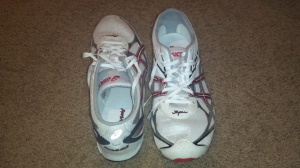Before running the Garmin Marathon this Saturday, I took my family to see Josh Cox, Desi Davila, and Scott Jurek speak at the expo. As you can see from the power point, their talk was titled “Life of An Elite Runner.” Alternate title: awesome stuff only a few gifted people will ever have the talent and opportunity to achieve.
There were lots of cool race stories, training tips, etc. However, I thought there was an unintentional life lesson that shone through that has application for all of us whether we are training, racing, or just living. All three of these athletes stressed the importance of having a goal race to work towards. Something to circle on your calendar. Something to accomplish.
As I’ve said before ad nauseam, I’ve run off and on my whole life. However, it wasn’t until about 3 years ago that I started racing. Nothing has improved my overall fitness and enjoyment of running more than the simple act of signing up for races. At first, one of my friends would spring a “hey, I’m running this 5K in a few weeks, do you want to do it too” on me and I’d join him. When I discovered that my tastes ran towards longer distances like the half and full marathon, I also discovered that a multi-month training plan was the only way to adequately prepare to race at those distances.
Hopefully you are in the home stretch of a training plan for Hospital Hill. If so, you are starting to smell that finish line as May is almost upon us. Having that finish line circled on your calendar gives you something to work towards. I’m in the recovery zone of a goal race right now – but I’ve already had HH circled on my calendar for months. I love having something new to look forward to and work towards already. I’ve already got another goal race planned after Hospital Hill. Do you? Whether you emerge injured or healthy, exhausted or raring for more – target something. When we stop setting finish lines out there in the future we stop the race. Never stop racing.




